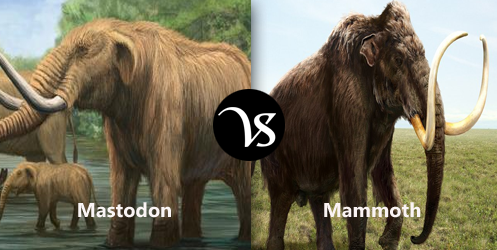 Mastodon:
Mastodon:
Mastodon are any species of extinct proboscideans in the genus Mammut, distantly related to elephants, that inhabited North and Central America during the late Miocene or late Pilocene up to their extinction at the end of the Peilstocene 10000 to 11000 years ago. Mastodons live in herds and were predominantly forest dwelling animals that fed on a mixed diet of browsing and grazing with a seasonal preference for browsing, in contrast to living elephants that are mostly grazing animals.
Mammoth:
A mammoth is any species of the extinct genus Mammuthus, proboscideans commonly equipped with long, curved tusks and in Northern species, a covering of long hair. They lived from Pliocene epoch into the Holocene at about 4500 years ago in Africa, Europe, Asia, and North America. They were members of the family Elephantidae which contains, along with mammoths, the two genera of modern elephants and their ancestors.
Differences:
| Basis | Mastodon | Mammoth |
|---|---|---|
| Definition (www.oxforddictionaries.com) |
A large extinct elephant-like mammal of the Miocene to Pleistocene epochs, having teeth of a relatively primitive form and number. | A large extinct elephant of the Pleistocene epoch, typically hairy with a sloping back and long curved tusks. |
| Synonyms | Hippopotamus, rhinoceros and elephant | Gigantic, monumental, colossal, immense and large |
| Antonyms | Miniature, teeny, little, tiny and common | |
| Period on Earth | They exist from Late Miocine to Pleistocene. | They exist from Pliocene epoch to Holocene. |
| History | Mastodons are any species of extinct proboscideans in the genus Mammut, distantly related to elephants, which inhabited North and Central America during the late Miocene or late Pliocene up to their extinction at the end of the Pleistocene 10,000 to 11,000 years ago. | The earliest known proboscideans, the clade that contains the elephants, existed about 55 million years ago around the Tethys Sea area. The closest relatives of the Proboscidea are the sirenians and the hyraxes. The family Elephantidae is known to have existed six million years ago in Africa, and includes the living elephants and the mammoths. A |
| Word origin | It was originated in Early 19th century: modern Latin, from Greek mastos ‘breast’ + odous, odont- ‘tooth’ | It was originated in Early 18th century: from Russian mamo(n)t, probably of Siberian origin. |
| Pronunciation |
|
|
| Life span | Their life span is 60 years. | Their life span is 60-80 years. |
| Weight | The weight is 5-8 tons. | The weight is 5.4 to 13 tons. |
| Native to | Africa, Europe, Asia; migrated to North America, South America | Africa, Europe, Asia, North America |
| Height | They have the height of 7 ft. to 8 ft. | They have the height of 8 ft. to 12 ft. |
| Ears | Their ears are small. | Their ears are large. |
| Tail | They have long and hairy tail. | They have short tail. |
| Tusks | Their tusks are long and curvy. | Their tusks are long and curvy. |
| Diet | They are Herbivore browsers/grazers – ate the leaves of tree leaves, shrubs, mosses, twigs, other plants. | They are Herbivore grazers – leaves, shrubs, grasses, herbs. |
| Family | The family is Mammutidae. | The family is Elephantidae. |
| Teeth | The teeth are cusped molars. | The teeth are a series of enamel plates; ridged molars. |
| Habitat | Forest dwelling, feeding on sylvan vegetation | Mammoth steppe – periglacial landscape with rich herb and grass vegetation |
| Kingdom | Animalia | Animalia |
| Phylum | Chordata | Chordata |
| Class | Mammalia | Mammalia |
| Order | Proboscidea | Proboscidea |
| Family | Mammutidae | Elephantidae |
| Genus | Mammut, Blumenbach, 1799 | Mammuthus, Brookes, 1828 |
| Period on Earth | They exist from Late Miocine to Pleistocene. | They exist from Pliocene epoch to Holocene. |
| Example in Sentence |
|
|





